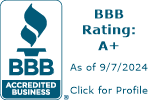Lawn Insects
Many insects live in lawns, but only a few can cause considerable damage and are important enough to require control measures. Naturescape® includes an insect control when necessary in your lawn program. Also, your Naturescape® specialist will be watching for an insect problem but if you ever suspect that you have an outbreak during the year, please call us and we will inspect the lawn. The following are the 3 most common lawn damaging insects in the Midwest.CHINCH BUGS
 Chinch bugs are tiny, winged or wingless insects. The adults, who are only 1/16 inch long, have black
bodies with white folded wings, the young nymphs are red with a black band on the abdomen. The adult
chinch bugs move very rapidly through the grass, and it is often quite difficult to locate them. In
order to find chinch bugs in the lawn, it will be necessary to get down on your hands and knees to make
careful observations.
Chinch bugs are tiny, winged or wingless insects. The adults, who are only 1/16 inch long, have black
bodies with white folded wings, the young nymphs are red with a black band on the abdomen. The adult
chinch bugs move very rapidly through the grass, and it is often quite difficult to locate them. In
order to find chinch bugs in the lawn, it will be necessary to get down on your hands and knees to make
careful observations.
Chinch bugs are most active in periods of hot, dry weather. Infestations can begin in June and may extend into September.
Chinch bug damage initially appears as patches of yellowing turf in areas where heat is radiated from sidewalks or driveways. The damage is often confused with drought problems at first. Later, the damage consists of small, irregular areas where the turf has completely disappeared. Quackgrass often moves into these vacant areas within a matter of weeks.
SOD WEBWORM
 Sod webworms are about 3/4 inch long, slender, cream or light brown in color with dark spots on the
backs. They live in silken tubes at the base of the plants. Sod webworms produce 2-3 generations each
year; therefore, the damage is likely to increase as the summer wears on. Adult webworms are small,
cream-colored moths that flit about over the lawn and cluster around lights in the evening. They have
a noticeable snout projecting in front of the head and fold their wings tightly against the body when
resting. These adults do not feed. All damage is caused by larvae feeding on grass blades. Birds picking
at lawns may indicate the presence of webworms. The first signs of sod webworm damage are areas of unevenly
cropped grass. Soon, large areas may turn brown and die. Close examination will show that the Sod Webworm
blades have been eaten away, with the bits of chewed foliage between the grass stems.
Sod webworms are about 3/4 inch long, slender, cream or light brown in color with dark spots on the
backs. They live in silken tubes at the base of the plants. Sod webworms produce 2-3 generations each
year; therefore, the damage is likely to increase as the summer wears on. Adult webworms are small,
cream-colored moths that flit about over the lawn and cluster around lights in the evening. They have
a noticeable snout projecting in front of the head and fold their wings tightly against the body when
resting. These adults do not feed. All damage is caused by larvae feeding on grass blades. Birds picking
at lawns may indicate the presence of webworms. The first signs of sod webworm damage are areas of unevenly
cropped grass. Soon, large areas may turn brown and die. Close examination will show that the Sod Webworm
blades have been eaten away, with the bits of chewed foliage between the grass stems.
GRUBS
 These are the larvae of the June beetle or the Japanese beetle. They are fat, white with brown heads, have
prominent legs with curved bodies measuring up to 1 inch long. Grubs eat the roots of grasses, causing
the turf to turn brown and die. Most species require 2-3 years to reach maturity, but some, including
the Japanese beetle have a 1-year cycle. If turf shows brown or dead areas, examine it first for grubs.
Grub-infested turf will be loose and can easily be pulled back to expose the insects.
These are the larvae of the June beetle or the Japanese beetle. They are fat, white with brown heads, have
prominent legs with curved bodies measuring up to 1 inch long. Grubs eat the roots of grasses, causing
the turf to turn brown and die. Most species require 2-3 years to reach maturity, but some, including
the Japanese beetle have a 1-year cycle. If turf shows brown or dead areas, examine it first for grubs.
Grub-infested turf will be loose and can easily be pulled back to expose the insects.
These tips are designed to help inform you about proper cultural practices such as mowing and watering and common basic lawn problems that may arise. If you ever have any concerns about your lawn or our services please call us.
The Naturescape® Guarantee
Your local Naturescape® branch is committed to making you happy with our service and your lawn and landscape. If you are not completely satisfied with the results of our services or you have any questions or concerns, please call your area branch office and we will be happy to take care of them within 72 hours. If necessary, we will gladly perform a free service call.
